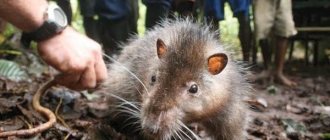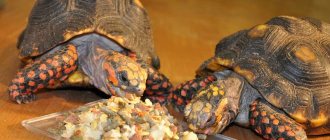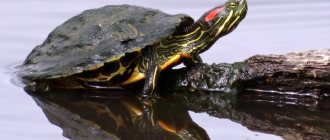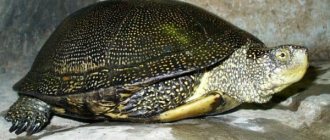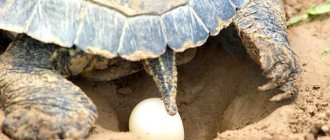Have you ever wondered what is the lifespan of a turtle ? According to scientific studies, the typical lifespan of pet turtles is between 50 and 100 years. However, several studies have shown that wild turtles can live up to 150 years or more. In 2006, a (reportedly) 255-year-old giant tortoise named Advaita died. Even if this turtle's age is wrong, a turtle named Jonathan will be 190 years old in 2022!
There are many species of turtles around the world, and they thrive in different temperatures. The actual lifespan of a turtle depends on many factors, including breed, habitat, care and nutrition. However, most turtles tend to be quite long-lived.
Giant tortoise living on the island of Aldabra (255 years old)
The gigantic tortoises from Aldabra Island are among the largest in the world. The diameter of their shell can reach 120 cm, and their weight is more than 250 kg. Giant turtles can stretch their necks to a distance of a meter, thanks to which this type of reptile is able to obtain food at quite a height. Unlike many other species, giant tortoises can eat anything, and sometimes even members of their own species. They are famous for their extraordinary longevity, but a turtle named Advaita, who lived in the city zoo in Kolkata, was truly a unique animal, as he died at the age of 255 years. Some scientists believe that Advaita is the oldest land mammal that ever lived.
Origin of the name
If we consider the Slavic and Latin origins of the name of the reptile, it is easy to see the commonality. Both languages demonstrate a response to appearance in the word: translated from Latin “tile”, “clay vessel”, “brick”; from Slavic - “shard”.
Indeed, many turtles resemble the stone for which the people who gave them this name mistook them. Despite this etymology of the name, it also contains an indication of the unique shape and color of the hard shells.
Freshwater mussel (280 years old)
Unfortunately, this species is endangered and is listed in the Red Book. Consequently, freshwater mussels are one of the shellfish species with the greatest risk of extinction from the face of the Earth. The species has suffered mainly due to human activities such as illegal pearling, habitat destruction and the decline of salmon species that play an important role in the breeding cycle. Freshwater mussels grow very slowly, so their average lifespan is between 86 and 102 years, but this largely depends on environmental factors in which they live, such as water quality, etc. The oldest mussel found was 280 years old.
Water scarcity on Earth is increasing: March 22 is World Water Day
The first country in the world to vaccinate its entire population against Covid
Dresses of Maria Feodorovna and more: The Hermitage made a gift to the Historical Museum
How to find out the age of turtles?
Radiocarbon dating of the shell makes it possible to most accurately determine the number of years. It was this method that made it possible to confirm the age of the oldest turtles in the world. Of course, such research cannot be carried out during life, but there is a more humane method.
Methods for determining age:
- Along the length of the shell. It tends to change evenly. Every year he gains 2 centimeters. It is not so difficult to take measurements and calculate if you know the initial length. The size of newborns is only 3 cm. Calculating the age is not difficult. For example, the length of the shell is 30 cm. If you subtract the initial size from the final size, 30 - 3 = 27, you get the number by which the turtle has grown in its entire life. Dividing it by 2 (the number of centimeters per year), the age is 13.5 years.
- Counting rings. This method is less accurate because it requires careful observations. The method should not be confused with determining the age of a tree; there is no need to cut anyone. You need to count the rings by the scales on the shell. More accurate results can be obtained on young animals. This is because in older individuals they are smoothed out. The turtle is 1 - 2 years old, if there are less than 6 scales. In one year, 2-3 rings are added.
Whatever method is chosen, none gives 100% accuracy of calculations. This is due to the fact that the growth and formation of the shell depends on the health of the animal, its diet and living conditions.
Greenland shark (400 years old)
A frightening look is not the only distinctive feature of sharks living in the waters of Greenland. They are also the oldest living vertebrate to swim the deep oceans. Greenland sharks do not reach sexual maturity until approximately 150 years of age and can live up to 400 years. It is noteworthy that such an impressive life expectancy for this species of shark is not an exception to the rule, but the norm.
Habitats
Turtles live in all tropical areas, as well as some places with temperate climates. Sea turtles swim in the warm ocean spaces of the Pacific, Atlantic and Indian Oceans. They are not found only near the Arctic and
Antarctica, which is natural, because all turtles love warmth.
Land turtles live in the steppes and semi-deserts of Africa, South and North America, Australia, and Asia. In Europe they can be found in the south, in a number of southern countries: Greece, Italy, Albania.
Quahog clam (507 years old)
Quahog is an edible species of bivalves. This species lives an incredibly long time, adding one layer to its shell every year. Quahog has exceptional longevity, and a compelling example of this is a clam named Ming, which lived a whopping 507 years, the highest age of any non-colonial animal species.
The release of the Resident Evil 4 remake has been postponed to 3023: game development has been restarted
Traveling around Russia and saving: how to get some money back for your trip
They Can't Chew: Things That Are Very Difficult for Cats to Do
What does a turtle prefer to eat at home?
If you have a pet turtle, its nutrition, maintenance and care should resemble its natural lifestyle. Before adopting a pet, study what it eats in nature and during what periods it is active.
Young individuals, as a rule, consume 70 percent of live food (food worms, insects, small crustaceans). Growing up, they switch almost entirely to plant foods. Suitable for feeding:
- vegetables and their tops (tomatoes, peppers, pumpkin, carrots, and occasionally cucumbers);
- berries (strawberries, wild strawberries, watermelon);
- fruits (plums, peaches, apples, bananas).
Do not overfeed the animal! If you see that there is food left after feeding, be sure to remove it and subsequently reduce the portions.
If you have a turtle at home, caring for it must necessarily include cleaning the aquarium. Be especially attentive to leftover food: stale food can lead to intestinal upset, which will affect how many years a turtle lives at home.
Atlantic roughy (over 110 years old)
This long-lived fish species lives in the depths of oceans around the world. They don't reach maturity until they are 20 years old and can live over 100 years! The maximum lifespan of the roughy is estimated to be 149 years. Today the species is under threat of extinction. Unfortunately, after 30 years of overfishing, the population of this species has decreased by 10-30%. In addition, roughy are often caught in bottom trawling, an activity whereby nets containing massive metal weights are pulled along the seabed, removing everything in their path. The nets have caused enormous damage to the species' habitats around the world. Because of its long lifespan, the Atlantic roughy reproduces and grows very slowly.
What to feed
Since turtles are predominantly herbivorous reptiles, they need to be fed plant foods: vegetables, herbs, fruits, berries or special store-bought food.
If you feed your animal food that you have prepared yourself, then all the food must first be finely chopped and chopped. It is imperative to add vitamins and minerals to your food. In the case of ready-made feeds, this is not necessary, since their composition is balanced and enriched with the necessary macro- and micronutrients.
The best foods for turtles, typical for Russian regions, are apples, carrots and white cabbage. Plus they are cheap and available all year round. In the summer, turtles can be offered everything that grows during this period in gardens, orchards, and even in the city: plantain, clover, dandelion, raspberries, currants, apricots. Large seeds should be removed from fruits and berries before feeding to pets.
Bakery products, dairy, fermented milk, fish, meat products, insects, skins of citrus plants and food for other domestic animals (cats, dogs, parrots and others) are extremely harmful to herbivorous reptiles.
Red sea urchin (approximately 200 years old)
If you've ever eaten sushi, chances are you've tasted the reproductive organs of a red urchin. This species can only be found in the waters of the Pacific Ocean. It lives on rocky shores and stays away from areas with intense currents. Sea urchins' bodies are completely covered in incredibly sharp spines, which help them protect themselves as they crawl along the ocean floor. Back in the century before last, scientists believed that the lifespan of these marine inhabitants was only 15 years, but recent research has yielded unexpected results. It turns out that this species can grow and develop throughout its life. Sea urchins age very slowly, so some specimens can easily live up to 200 years. Surprisingly, red hedgehogs are one of the oldest animals on Earth. They existed during the Paleozoic.
Appetizing cakes with a creamy texture in the form of cute flowers
Coincidentally or not: why Lady Di put a necklace on her head, which upset the queen
To avoid harm to health: choose frying oil with a high smoke point
Features of character and lifestyle
Photo: Leatherback turtle
Sea turtles have a calm nature. They are leisurely, although they are capable of swimming quite quickly and well. Sea turtles spend their entire life in water. Turtles stay in shallow water near the shores, however, when hunting they can dive deep into the water and stay there for a long time.
All sea turtles make long migrations in order to have offspring. No matter how far turtles are from the warm tropical shores where they were once born, when the time comes, they return there to lay eggs. In this case, one turtle always forms a clutch in the same place. Turtles breed at the same time and on the shores during the breeding season you can see hundreds of females laying eggs.
The social environment of sea turtles is undeveloped. Turtles most often live alone. Young turtles, hiding from predators, spend almost all their time in algae thickets, where they can feel safe. Older turtles swim freely in the water. Sometimes sea turtles like to bask in the sun by climbing on rocks.
Under poor environmental conditions and lack of food, sea turtles are capable of falling into a kind of suspended animation. At this time, turtles become lethargic and eat little. This helps turtles survive during winter. In winter, turtles sink to the bottom and can live anaerobically for a long time without swimming to the surface.
Bowhead (or arctic) whale (211 years old)
The bowhead whale is not as famous as the blue whale, but it has some distinctive features that make it a one-of-a-kind species. Firstly, it has the largest mouth of any animal, and secondly, this creature can live for over 200 years, making it the longest living mammal. The oldest known specimen of this whale species was 211 years old.
Sexual characteristics of a turtle
The sex of turtles is determined by appearance and behavior, since these animals do not have clear genital differences, and it is almost impossible to figure out the sex at first glance. However, males differ from females:
- according to the shape of the shell (in females it is more elongated);
- the lower part of the shell is slightly concave in males, flat in females;
- the tail of males is longer, wider and thicker, it is more curved down;
- according to the shape of the anus;
- in males, the claws of the front paws are slightly longer;
- a small notch in the shell in the tail area is present only in males;
- The behavior of males is characterized by activity.
In some species, gender, in addition to the indicated characteristics, is expressed by the color or shape of the head.
Giant tube worm (up to 250 years)
The giant tube worm lives at depths of 500 to 800 meters, near cold currents, in places where oil and methane escape from the seabed. It lives in symbiosis with oxidizing sulfur bacteria that live on its body. The giant tube worm can reach a length of more than three meters (but grows very slowly) and live up to 250 years. Tube worms usually live in large groups numbering thousands of individuals.
Emigration to the USA and an unsuccessful marriage: how the life of the beauty Natalia Lapina turned out
Children who spend more than an hour a day on the phone will have social problems
Malaysian artist creates stunning surreal photo illusions
Interesting Facts
- It was turtles that were the first to fly around our moon, on board an experimental research probe launched by the Soviet Union back in 1968.
- Turtle meat is an expensive and delicious product in some cuisines around the world.
- Turtles are also present in heraldry, in the depiction of the coats of arms of some cities.
- Despite the fact that turtles do not pose a danger to humans, there are exceptions, for example, male leatherback turtles can confuse a swimmer with a female, grab them with their paws and drag them to the bottom.
- The sex of turtles in the egg is determined by the ambient temperature. At lower temperatures, males are born, at higher temperatures, females are born.
Koi carp (226 years old)
Koi (also known as brocade carp) are a domesticated ornamental species of common carp. In general, brocade carp live up to 50 years, but one pet specimen named Hanako became the longest-living living fish ever recorded. He died at the age of 226, and it is still a mystery why he lived so long. Most scientists are of the opinion that koi simply enjoy life, receive love and care from their owners, and also have the opportunity to swim in the crystal waters of the Japanese mountains.
Found a violation? Report content
Crumbs in the shell: the life period of little turtles
Not everyone is ready to have a large reptile at home. Much more often, babies up to 13 cm in size act as original pets. Despite their miniature size, such “cuties” live quite a long time.
Lifespan of a tiny turtle:
- three-keel - from 20 to 25 years;
- musky - 23;
- spotted - from 30 to 40;
- silt - from 50 to 60;
- Reeves (pond) - 58.
What to avoid when keeping
Despite the apparent indifference to everything that surrounds it, the turtle can experience severe stress. If Central Asian land turtles live in captivity, they are sensitive to the attitude of their owners towards them. Loud sounds in the house and rude screams disturb the usual calm environment and can lead the animal to a nervous breakdown. Therefore, you should take the following postulates as a rule:
- Be careful when handling the reptile, do not drop the animal or frighten it with sharp sounds. If children play with the pet, adults should supervise the process.
- If you notice anything strange in your reptile's behavior or appearance, do not delay checking with a veterinarian. Refusal to eat, changes in the shape of the shell, lethargy, the appearance of tumors and ulcers are serious signals of illness.
- When purchasing new armored reptiles, quarantine them for a month. At this time, the future neighbor must live separately.
- Do not keep reptiles of different species in the same terrarium.
- If the reptile escaped from the aquarium and cannot be found, place a bowl of water and your pet's favorite food indoors. Turtles have good eyesight and will respond quickly to treats and water.
- Remember that the depth of the reservoir should allow the animal to easily stick its head out and keep it on the surface.
- Install two thermometers in the aquarium: one for water, the other for air.
Reproduction
It is almost impossible to determine the sex of a land turtle under 2 years of age. Signs that can be used to identify an older animal are as follows:
- Dimensions. Females are slightly larger than males. Using this feature, it is possible to identify a male only if there are several individuals in the terrarium.
- Carapace and plastron. In the lower part, the bone plates of males are concave, since during mating they climb onto females. In females, the carapace is more rounded, in male specimens it is elongated.
- The claws of males are sharper and stronger than those of females. With their help, males hold females during mating.
- The tail of males is wider, more powerful and longer, since it contains the genital organ.
- Eye color will also help determine the sex of the turtle. In the female they are usually yellow, and in the male they are brown.
In nature, mating of individuals occurs in the spring after the end of the winter period, during which some species hibernate.
Breeding at home is a rather difficult process. Mature animals are kept together, usually one male and a pair of females. To do this, you need to build a large terrarium or a warm outdoor enclosure. Pet turtles can mate year-round; all that is needed is adequate temperature and humidity, as well as increased nutrition.
In the banded turtle species, it is necessary to have one male per female, and in caiman turtles this ratio is 2:1.
To stimulate mating, turtles are hibernated during the winter and males and females are separated for a couple of months. Then the temperature in the enclosure or terrarium is gradually increased, simulating spring.
Sometimes they do without forced wintering, but simply shade the terrarium for three months, reducing the air temperature to the lower permissible limit, then also gradually increase the degree of room heating and illumination.
Daylight hours are increased to 14-15 hours, and turtles are sprayed with water from a spray bottle every day for the last two weeks, simulating rain. Then the male is placed with the females, in their room. In this case, the male will behave less aggressively.
If there are two males in the terrarium, then joints are possible between them and there is no need to prevent them to a reasonable extent.
Reproduction is easiest in Central Asian species; they usually do not need stimulation.
After mating has occurred, you need to monitor the female, and as soon as she lays a clutch, immediately move the eggs to the incubator. They mature in 2 to 6 months.
A large glass, clay or porcelain container or an aquarium can be used as an incubator. Peat mixed with river sand in a ratio of 3:2 is poured onto the bottom. It is advisable to pre-calcinate the soil. You can take moistened vermiculite - a special crystalline substrate used in plant growing.
The soil in the incubator must be moist, and the eggs must be placed in special nests - small holes, recessed to a third of the height. During the entire period of egg ripening, sand is lightly sprinkled with water along the edges of the vessel, while avoiding excessive moisture.
You can also place a small jar of water in the vessel; it will evaporate and maintain air humidity at the required level.
The incubator is covered from above, preferably with glass, which is removed a couple of times a week for ventilation.
The soil from below is heated with an electric lamp or a vessel is placed near the heating device. The main thing is to maintain a constant level of temperature and humidity. Therefore, it is better to equip the incubator with a hygrometer and thermometer.
Too high a temperature can destroy the clutch, so it wouldn’t hurt to install a special thermostat in the container with the baby turtles’ eggs.
After the turtles have hatched, there is no need to rush to remove them from the eggs. They feed on their plant solution for up to three days. Even when the baby is completely freed from the shell, the remains of the yolk sac remain on the plastron below.
Turtles can grow up to three months old, feeding only on this yolk. Sometimes they hibernate and spend up to six months in it, gradually growing up.
From the first days, young turtles are able to take care of themselves. They just need to be moistened from time to time to prevent dehydration.
When kept in a terrarium, babies begin to be fed plant foods from the second month of life, but they are given baths every week.
Causes of premature death
The most common causes of death of pets are:
- Improper conditions of detention. Small aquarium, dirty unfiltered water, untimely cleaning, inappropriate temperature conditions.
- Infections. They can appear from aquarium plants, decorative elements, and live food.
- Poor nutrition and lack of vitamins. In nature, a turtle can compensate for the deficiency of any element on its own; when kept at home, monitoring the diet is the owner’s task.
- Lack of qualified veterinary specialists who can correctly and timely diagnose health problems and prescribe adequate treatment.
Red-eared turtles in nature
